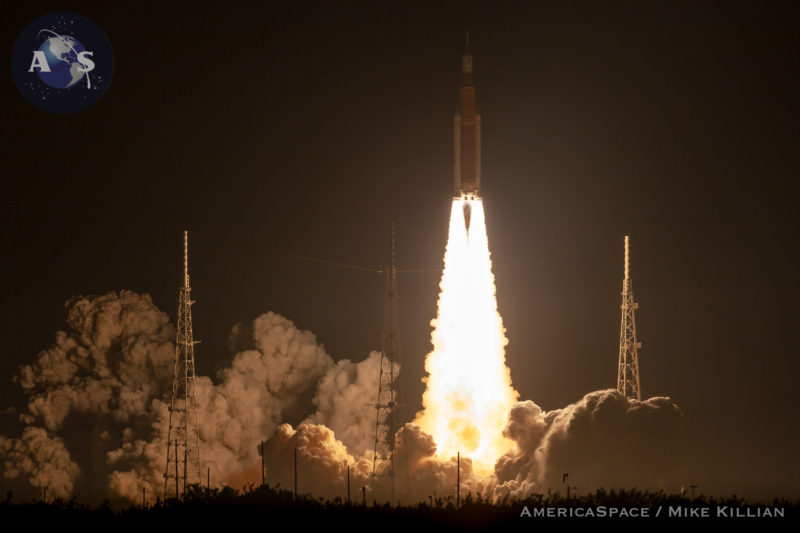
After more than a decade in development, and almost three months since its initial pair of ill-fated launch attempts in late August and early September, NASA’s mammoth Space Launch System (SLS) rocket finally took flight from historic Pad 39B at the Kennedy Space Center (KSC) in the early hours of Wednesday morning. Liftoff of the Artemis I mission—which will send an uncrewed Orion Crew Module (CM) and European Service Module (ESM) on an approximately 25.5-day trek to the Moon and back—came at the start of a two-hour “launch window” at 1:47:44 a.m. EST.
It became the first U.S. crew-capable rocket to fly its maiden voyage in the hours of darkness. Speaking back in September, NASA Associate Administrator for the Exploration Systems Development Mission Directorate Jim Free noted that although the agency’s preference always was to fly in daylight, as “visuals from our long-range tracking are of benefit to us”, there nevertheless remain “some ways to view the vehicle” if the SLS did fly its first launch at night.
And in the small hours of this morning, it did.
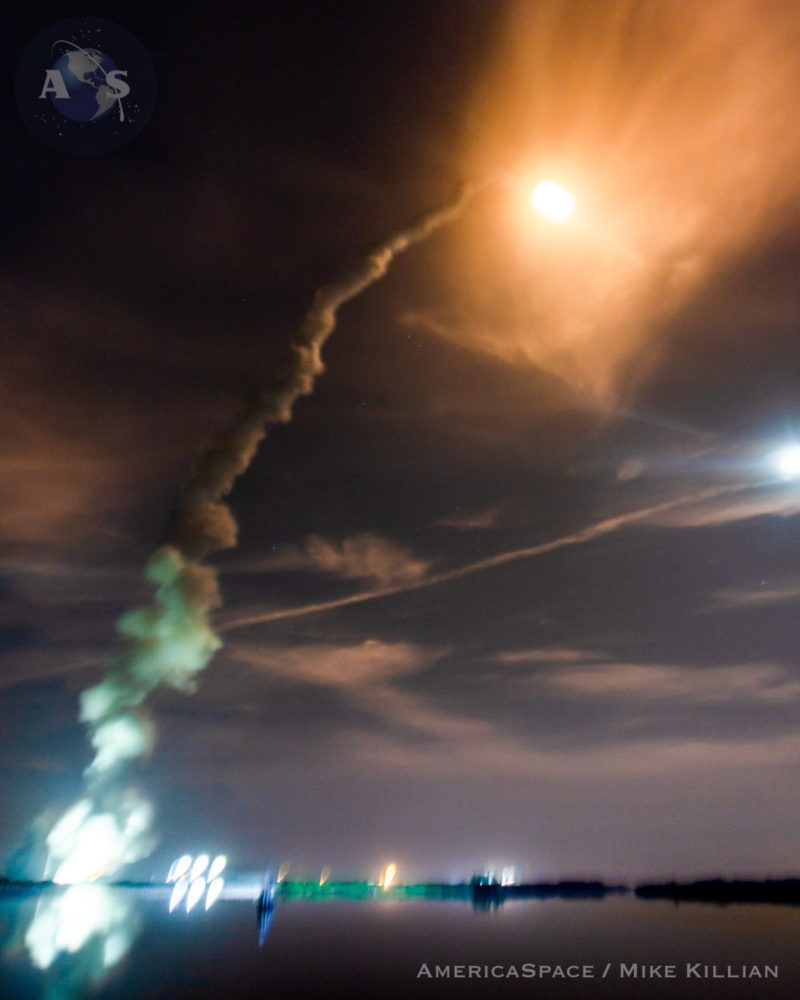
In some ways, Artemis I’s spectacular liftoff drew uncanny parallels with Apollo 17, the most recent flight of humans to lunar distance. Launched at 12:33 a.m. EST on 6 December 1972 atop a mighty Saturn V, that mission to the Moon’s Taurus-Littrow highland region saw Commander Gene Cernan and his Apollo 17 crewmates, Command Module Pilot (CMP) Ron Evans and Lunar Module Pilot (LMP) Harrison “Jack” Schmitt, turn Florida’s night into day with their own man-made sunrise.
Theirs was the first U.S. crewed night launch and, until this morning’s spectacular rise of the SLS and Artemis I, the only Moon-bound flight of a crew-capable vehicle to fly under cover of darkness. Aboard Apollo 17, Cernan later remembered the fiery glare of the Saturn reflecting off the clouds and the interior of the shuddering cabin seemed “painted” with an ethereal reddish hue.
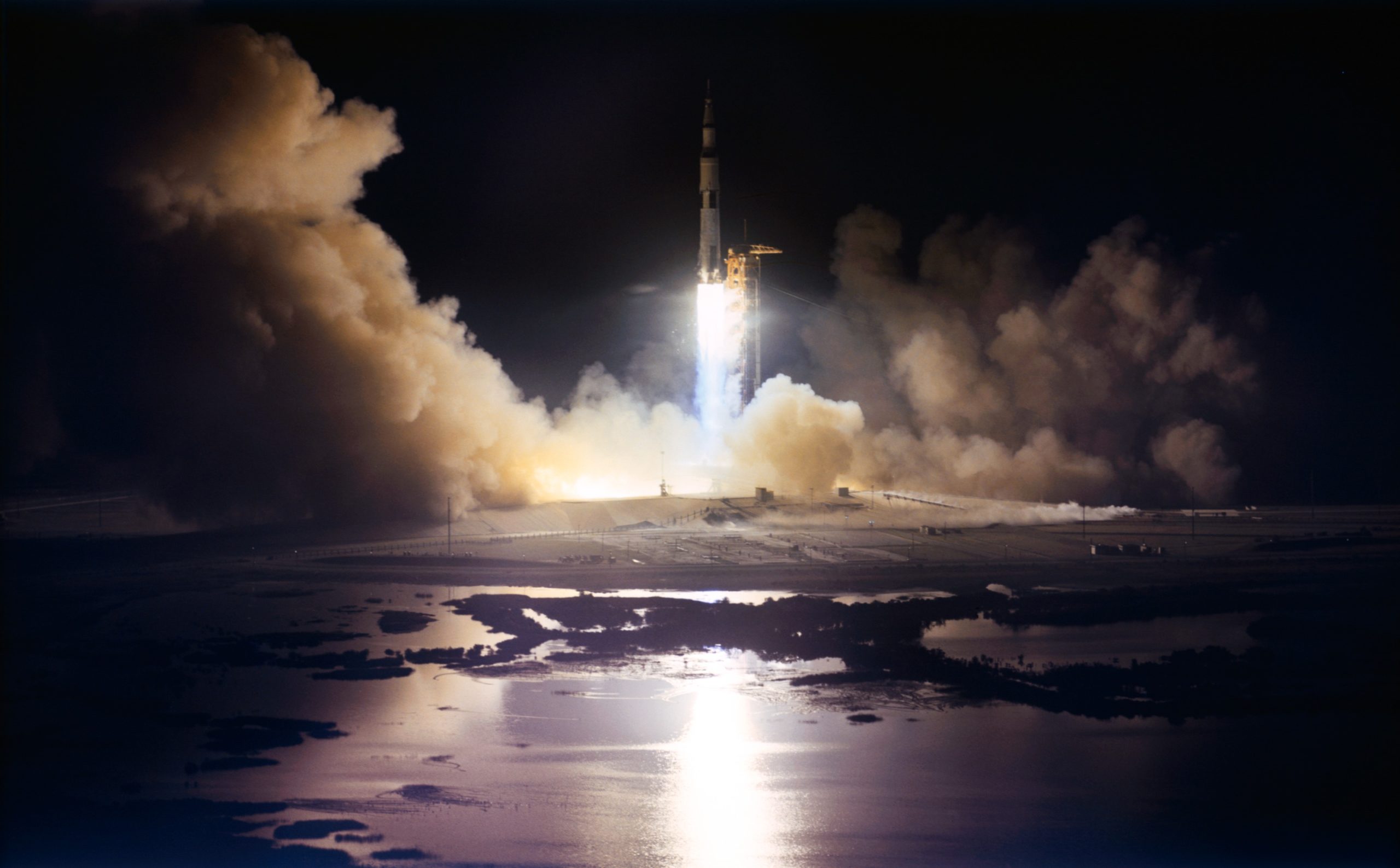
“It’s lighting up the sky,” breathed an astonished NASA public affairs commentator Jack King as Apollo 17 speared skyward, almost a half-century ago. “It’s just like daylight here at the Kennedy Space Center.”
But this morning’s long-hoped-for launch comes after multiple months of frustration. The 322-foot-tall (98-meter) SLS—the “business end” of which comprises the 212-foot-tall (64.6-meter) Boeing-built Core Stage with four shuttle-era RS-25 engines and a pair of five-segment Solid Rocket Boosters (SRBs), fabricated by Northrop Grumman Corp.—rolled out from KSC’s iconic Vehicle Assembly Building (VAB) to Pad 39B in mid-August, tracking an opening salvo of launch attempts in late August and early September.

But the first launch try on the 29th came disappointingly to nought when efforts to thermally condition the RS-25 engines ahead of ignition met with stubborn resistance from Engine No. 3, which refused to reach its requisite temperature range around 500 Rankine. Added to Artemis I’s woes was a notable “spike” in the amount of hydrogen leakage into the “purge can”, a housing which covers the Tail Service Mast (TSM) umbilical’s 8-inch (20-centimeter) quick-disconnect fitting. Engineers managed the leak by manually adjusting propellant flow rates.
NASA next aimed to fly on 3 September, with plans to chill-down the engines 30-45 minutes sooner in the countdown in hopes of solving the recalcitrant thermal conditioning issue and avoid the necessity of rolling the stack back to the VAB. A flex-hose and loose pressure sensor line were replaced and bolts were tightened as part of efforts to rectify the TSM umbilical leak.
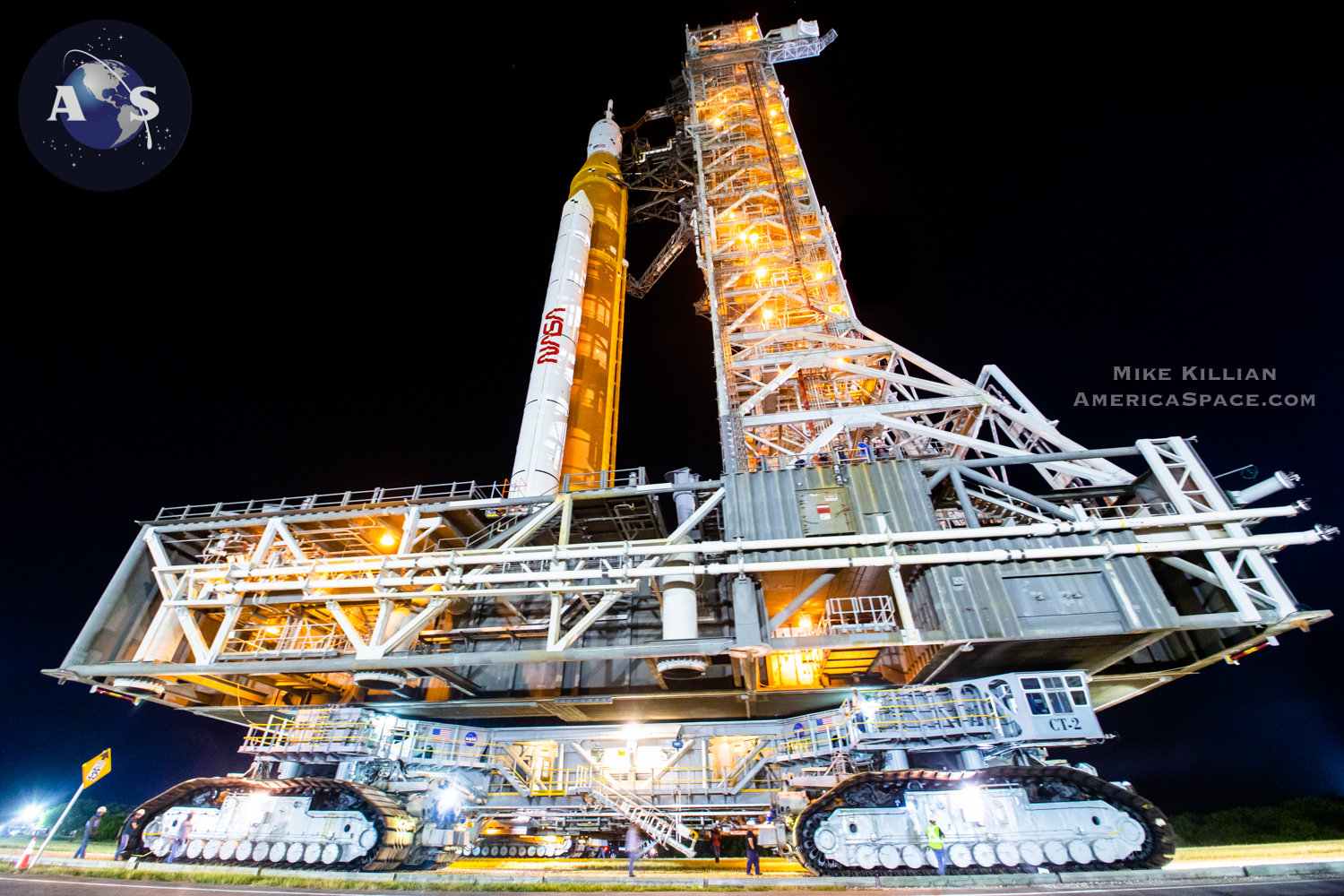
But the second attempt also proved fruitless, as the hydrogen leak—situated right on the interface between the ground-side and flight-side plates of the quick disconnect fitting—recurred and proved maddeningly intractable. Three tries by engineers to re-seat the seal came to nothing and the 3 September attempt, too, was scrubbed.
Hopes of a third try in early September were abandoned, as teams established a tent-like weather/environmental protection shelter around the base of the SLS and the 8-inch quick disconnect for exploratory and repair work. They replaced a pair of seals: one around the 8-inch interface and another around the 4-inch (10-centimeter) bleed line which would used to redirect some propellant during the tanking process.
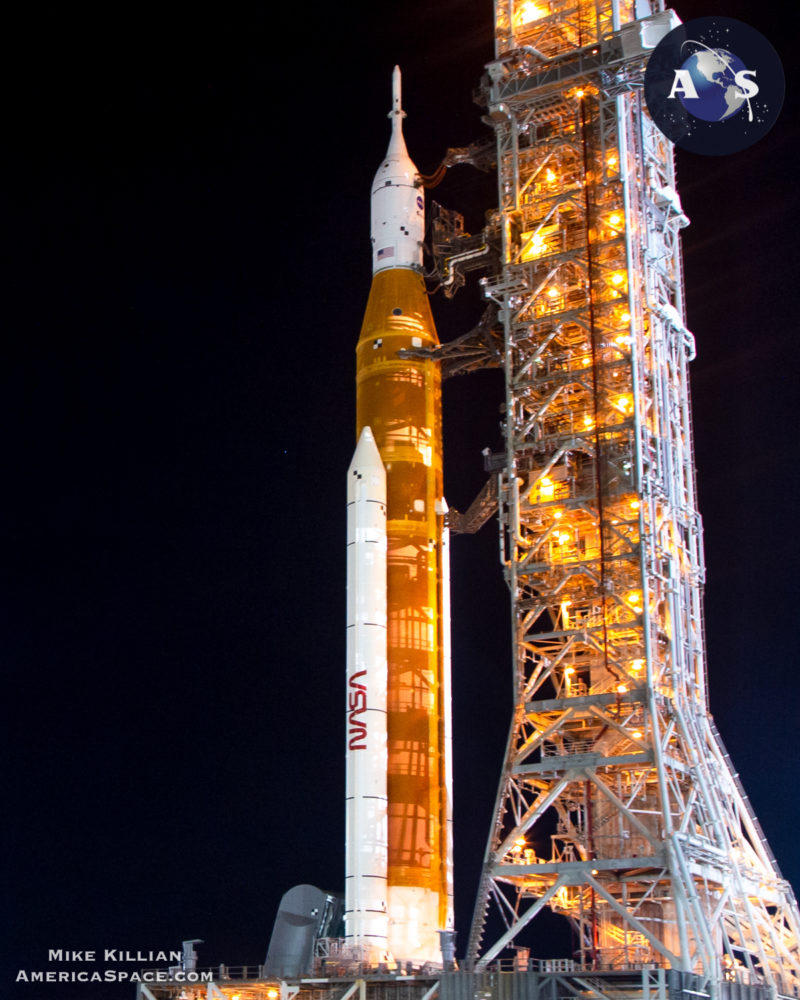
A cryogenic test of the repair, originally targeted for 17 September, eventually took place on the 21st, following what NASA described as “careful consideration of multiple logistical steps”. All four objectives of the test—assessing the effectiveness of the hydrogen leak repair, loading propellants successfully into the SLS tanks under new procedures, conducting a “kick-start bleed” to thermally condition the RS-25 engines and performing a pre-pressurization test—were satisfactorily completed.
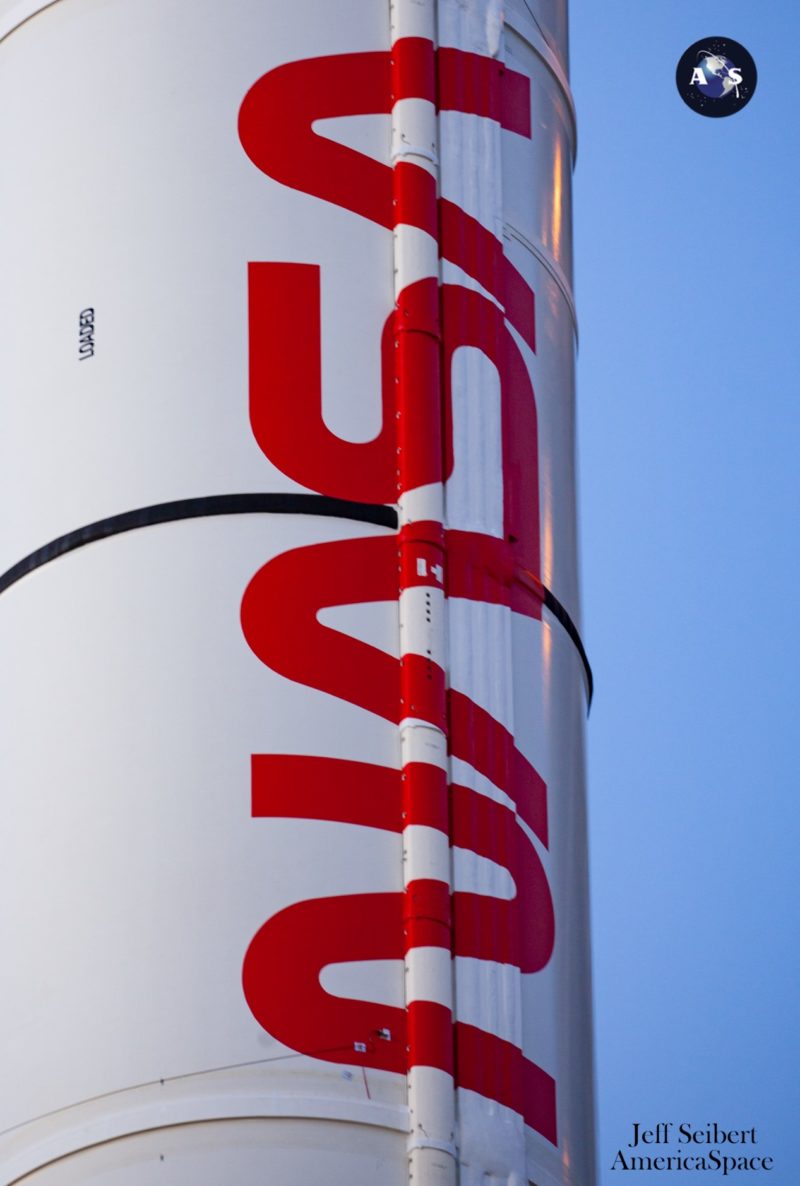
Notably, the “pre-press test” allowed engineers to bring the Core Stage liquid hydrogen tank up to the kind of pressures that it would experience just before launch. The success of the cryogenic test allowed tentative steps towards a pair of launch opportunities on 23 and 27 September, but Mother Nature (in the form of Hurricane Ian) stepped in the way. The giant rocket was returned to the VAB overnight on 26/27 September.
By now, the next realistic chances to launch lay in November, spanning a two-week period from the 12th through the 27th. Last month, NASA announced its intent to aim for an opening attempt at 12:07 a.m. EST on 14 November, as efforts inside the VAB saw engineers replace the rocket’s Flight Termination System (FTS) batteries, recharge payloads and tend to minor Thermal Protection System (TPS) damage.
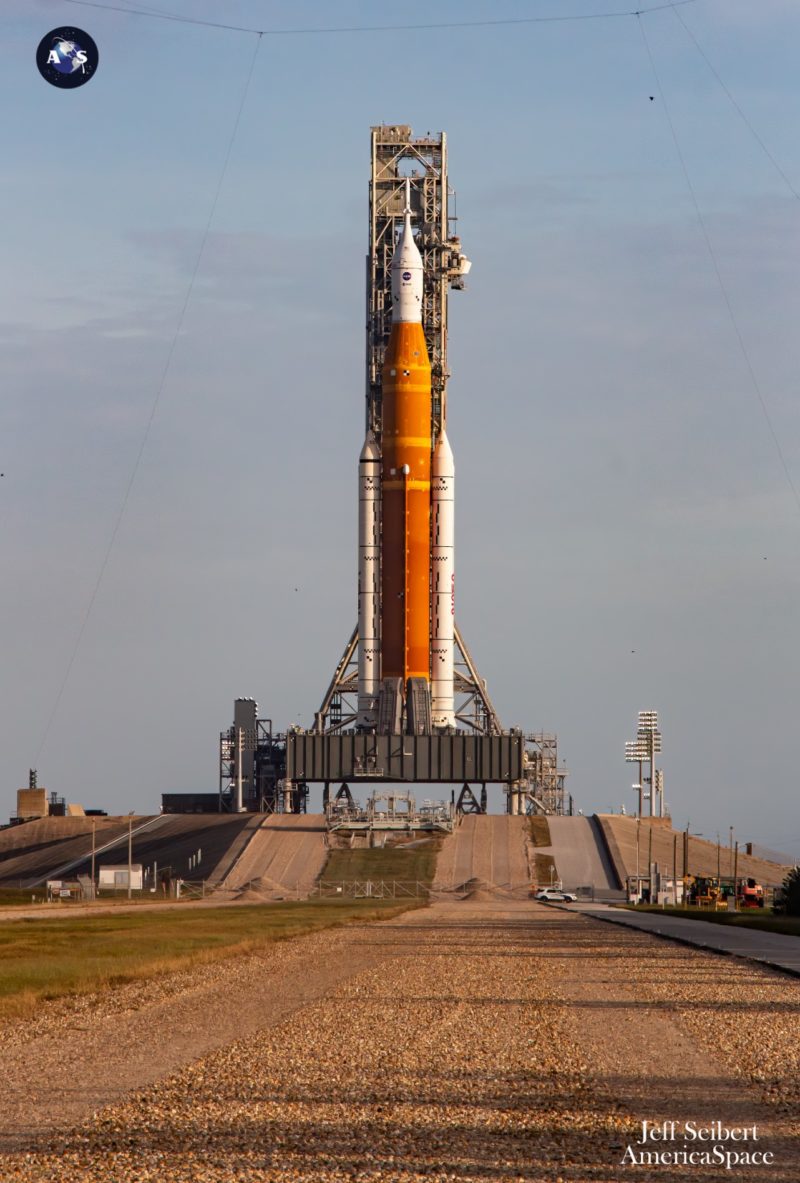
This month began with the overnight rollout of the stack to the pad on 3/4 November, but the approaching menace of Hurricane Nicole—which forced the four-day postponement of a SpaceX Falcon 9 launch last week—added another delay to no sooner than 1:04 a.m. EST on the 16th. Despite Nicole’s impact, which produced a Hurricane Condition (HURCON) III status and saw peak wind gusts of 82 mph (132 km/h), the SLS stack remained safe, steady and secure on Pad 39B.
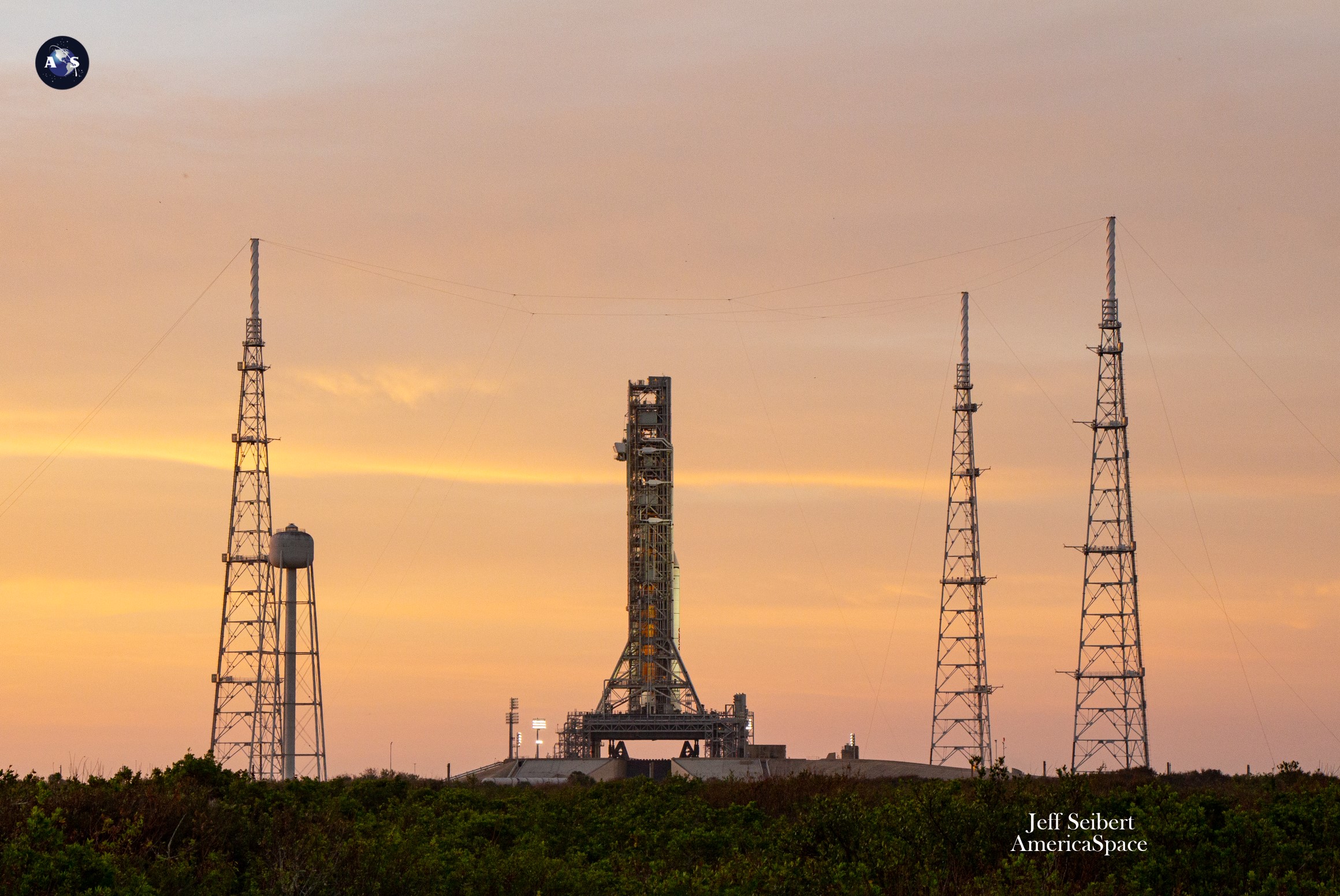
The giant rocket was designed to withstand winds of 85 mph (136.8 km/h), as well as heavy rains at the pad. “We took the decision to keep Orion and SLS at the launch pad very seriously,” said Mr. Free, “reviewing the data in front of us and making the best decision possible with high uncertainty in predicting the weather, four days out.”
Last weekend, engineers conducted a detailed analysis of some delaminated caulk at the junction between Orion’s CM adapter and the ogive-shaped panels of the SLS Launch Abort System (LAS). A component of an electrical connector on the TSM’s ground-side plate was also replaced.
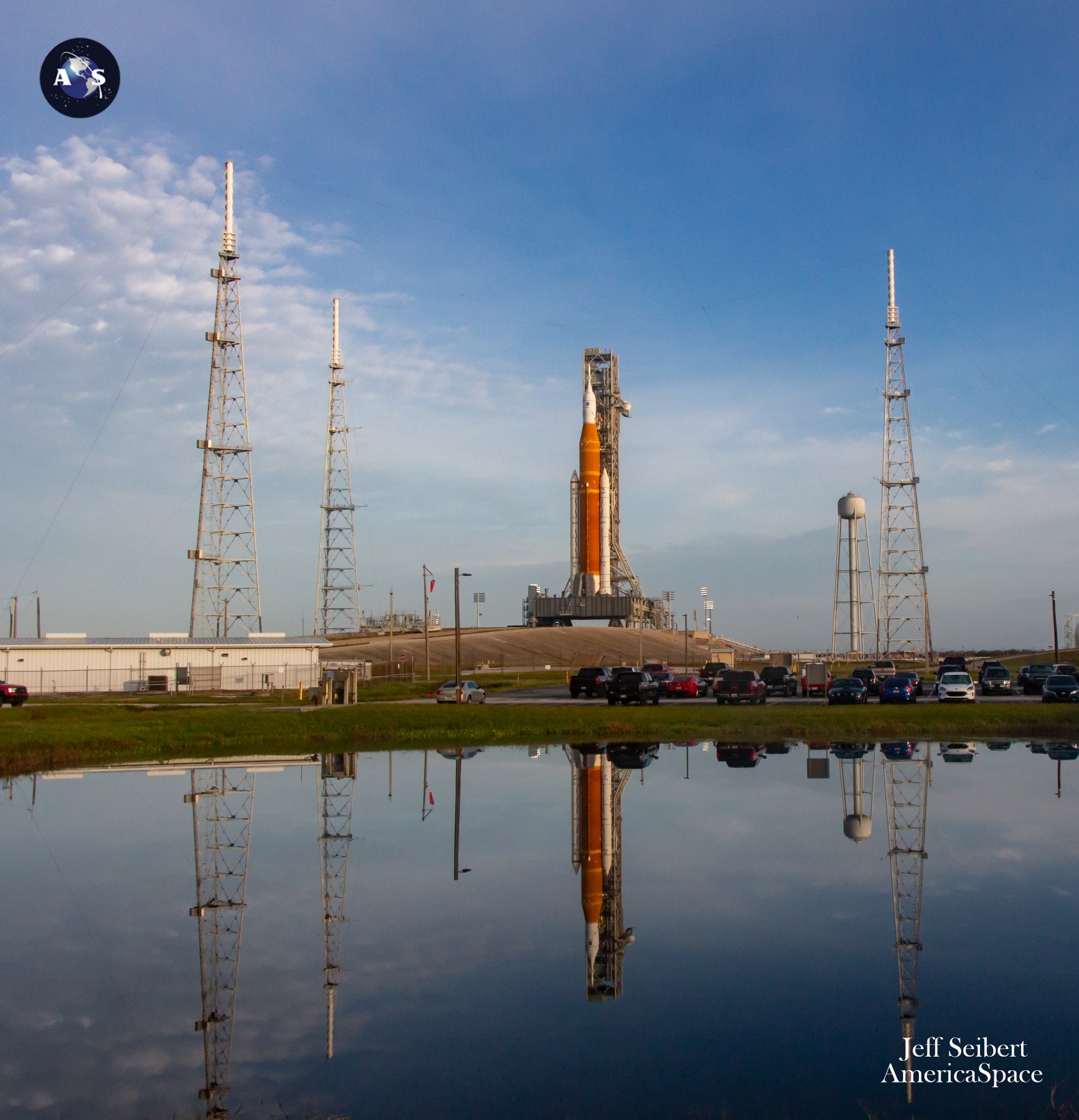
Weather for Wednesday morning’s opening launch attempt stood firm at 90-percent favorable, according to meteorologists at the 45th Weather Squadron at Patrick Space Force Base. There remained a slight risk of violating the Cumulus Cloud Rule.
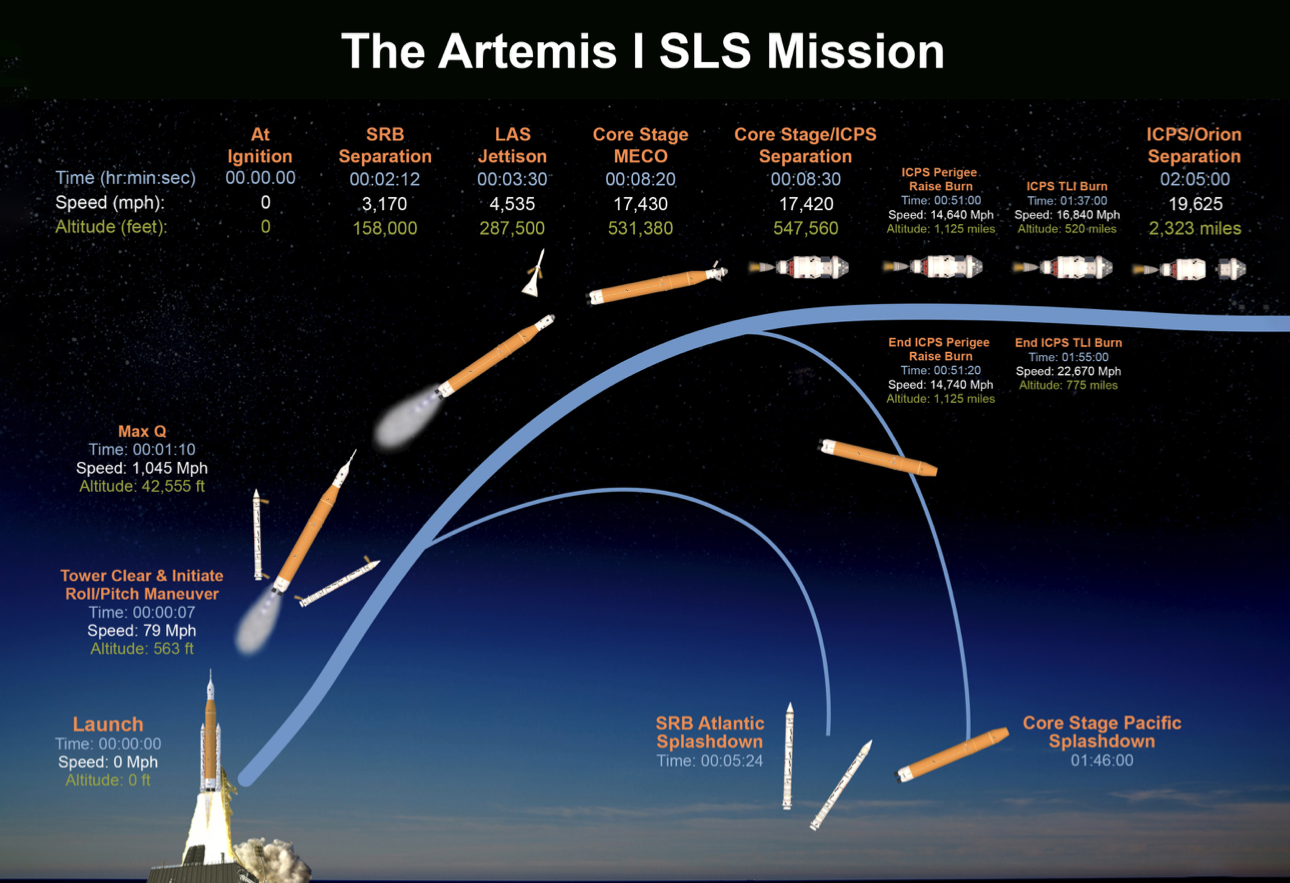
“On Tuesday, a non-tropical gulf low near Louisiana will progress rapidly northeast, reaching the Deep South by the evening,” the 45th noted in a Monday morning update. “The Florida Peninsula will be in the warm sector of the system into Tuesday night, causing temperatures and humidity values to rise.
“However, the system will likely be too far away to otherwise impact local weather conditions across the Spaceport early Wednesday morning,” it was added. “As a result, excellent weather is expected during the primary launch window, with the Cumulus Cloud Rule being only a minor concern.”
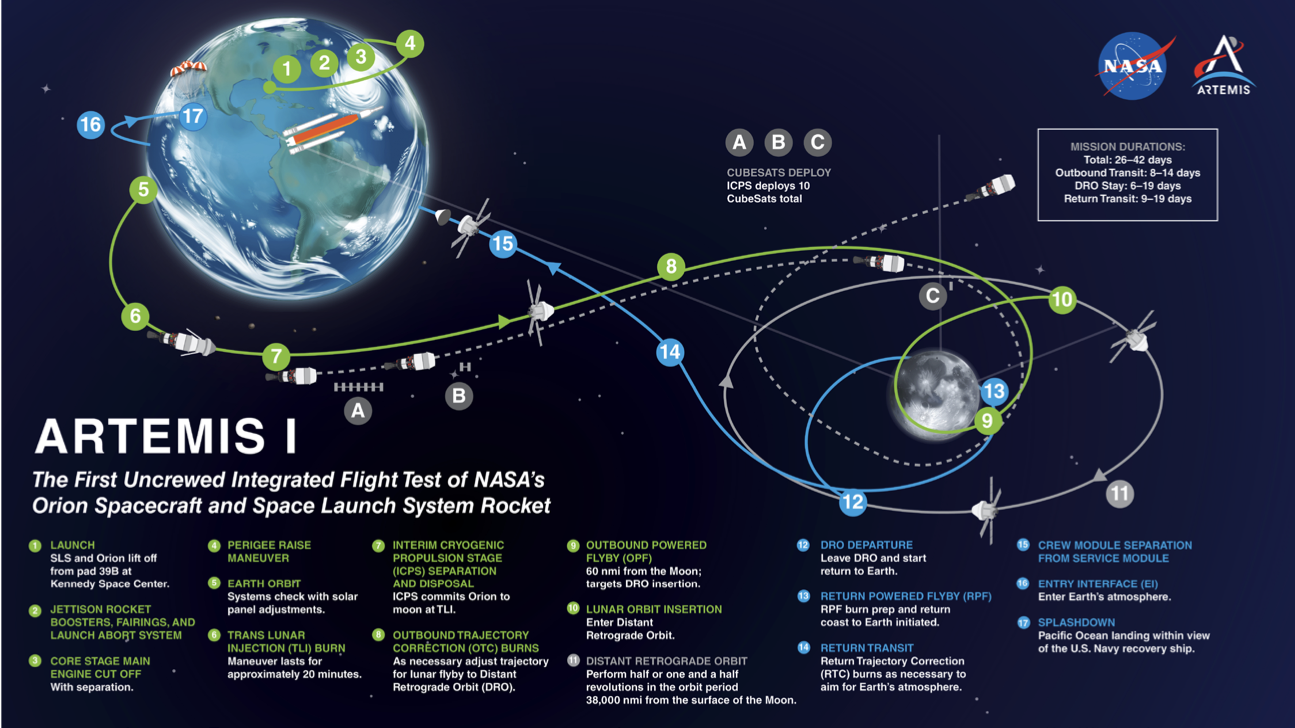
Countdown operations commenced at 1:54 a.m. EST Monday, shortly after the Artemis I flight control team received their formal “Call to Stations”. The Blast Danger Area around Pad 39B was cleared just after noon EST Tuesday, ahead of the countdown’s first built-in hold at T-6 hours and 40 minutes.
During the hold—which was lengthened to 3.5 hours total—the launch team conducted weather and tanking briefings, before Artemis I Launch Director Charlie Blackwell-Thompson authorized the loading of more than 733,000 gallons (3.3 million liters) of liquid oxygen and hydrogen propellants into the Core Stage and the rocket’s 45-foot-tall (13.7-meter) upper stage, known as the Interim Cryogenic Propulsion Stage (ICPS).
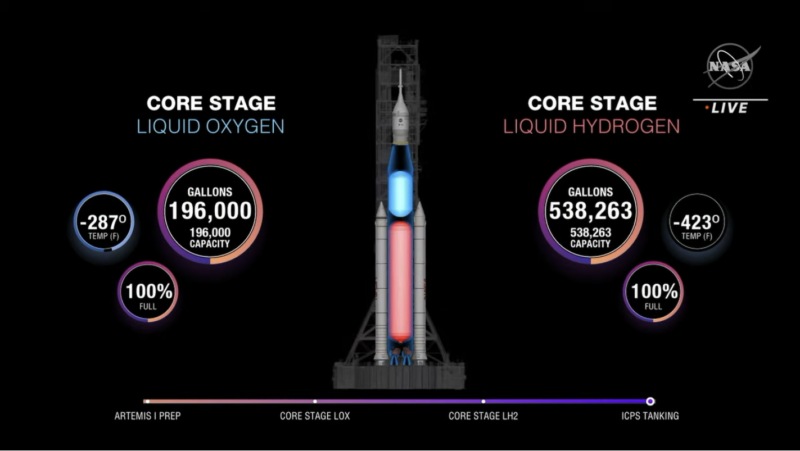
Fueling occurred in a two-step fashion, with the Core Stage tanks firstly slow-filled, then fast-filled, ahead of the kick-start bleed test to thermally condition the four RS-25 engines as the late afternoon faded into dusk. As night fell, topping and replenishment of the Core Stage got underway and the ICPS was itself loaded with 22,000 gallons (100,000 liters) of liquid oxygen and hydrogen.
Shortly after 9:30 p.m. EST, the fueling process was interrupted by the appearance of a small leak on a hydrogen valve in the Mobile Launcher (ML). A “red crew” of technicians were dispatched to the pad and entered the ML’s base area—or “zero deck”—and tightened several bolts to ensure that the valve was secure. The issue did not recur.
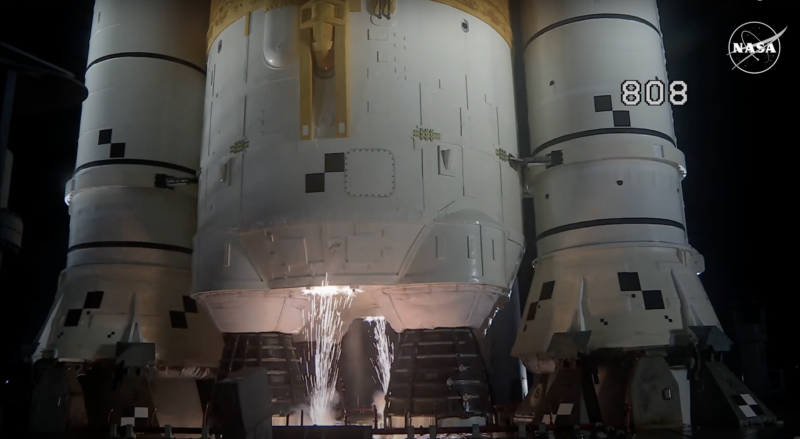
But shortly before 1 a.m. EST, with the countdown clock holding in its final built-in hold at T-10 minutes, a delay was announced. Teams extended the built-in hold past its targeted 30 minutes, revealing that the Eastern Range had resolved a loss-of-signal issue pertaining to a radar site and were working through tests to ensure satisfactory communication and tracking of the SLS.
As the countdown moved deep inside its final hour, a final briefing was held by NASA Test Director (NTD) Jeff Spaulding was held and Ms. Blackwell-Thompson polled her team for their preparedness to launch. “For the Artemis Generation,” she said in her final remarks, “this is for you!”
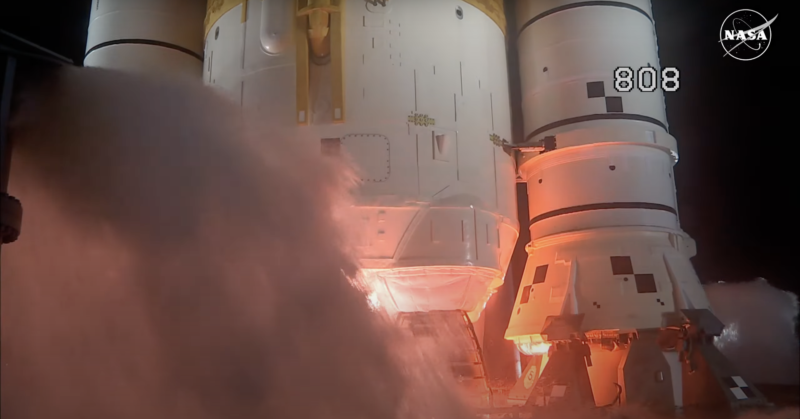
With a “Clear Constraints Board”, the countdown resumed from its final built-in hold at T-10 minutes at 1:37 a.m. EST, tracking a revised T-0 at 1:47:44 a.m. EST. At this point, the Ground Launch Sequencer (GLS) took control and the pace of automated activities picked up.
Over the next few excitement-tinged minutes, GLS commanded the pressurization of the SLS Core Stage tanks, armed the FTS for flight and finally handed off control of the countdown to the rocket’s autosequencer at T-33 seconds. In a fashion oddly akin to the final moments before shuttle launches of yesteryear, the familiar hydrogen burn-off igniters appeared at T-12 seconds, before the four RS-25s themselves roared alive at staggered intervals at T-6.6 seconds.
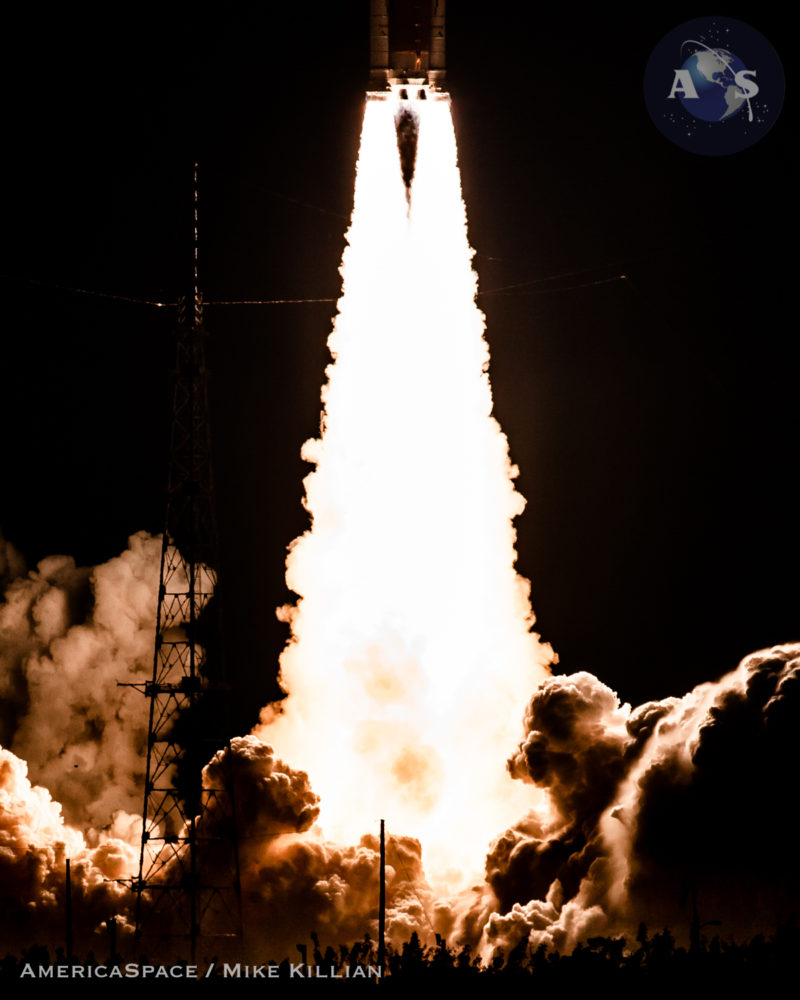
Those four engines previously supported 21 shuttle missions from John Glenn’s history return to space in October 1998 to the final voyage of the program in July 2011. At T-0, Northrop Grumman’s five-segment SRBs ignited with a characteristic staccato crackle and Artemis I went airborne at 1:47:44 a.m. EST under a combined thrust of 8.8 million pounds (3.9 million kilograms).
Punching out more than 1.1 million pounds (500,000 kilograms) greater thrust than did the Saturn V at liftoff, with today’s flight Artemis I went into the record books as the most powerful rocket ever successfully launched into orbit. Although the Soviet Union’s ill-fated N-1 lunar rocket was capable of 10.2 million pounds (4.6 million kilograms) at liftoff, its four attempted launches between February 1969 and November 1972 all failed.
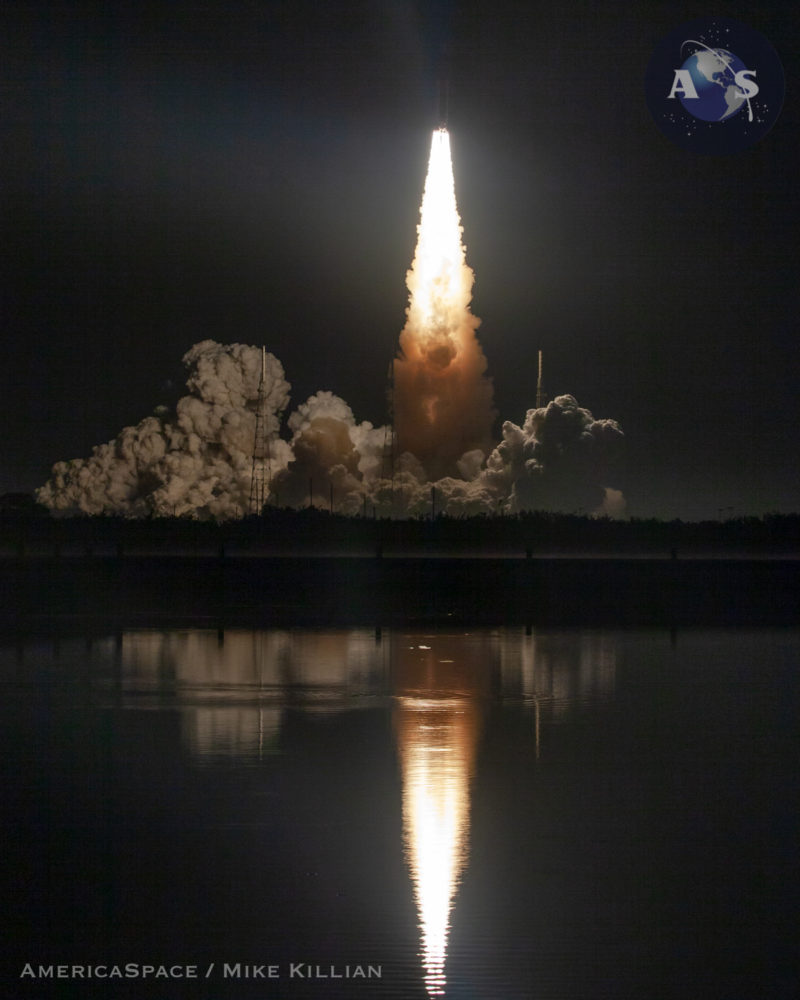
In some ways, Artemis I’s launch architecture was not unlike the shuttle, with the SLS performing a “roll program” maneuver at seven seconds after liftoff to enter a “heads-down” orientation for Orion. Pummeling the ears and the soles of the feet of spectators, she headed swiftly downrange, going supersonic at 54 seconds and passing the point of maximum aerodynamic turbulence on her airframe—known colloquially as “Max Q”—at 70 seconds.
In another feature not unlike the shuttle, the twin SRBs expended their propellant and were jettisoned from the stack at two minutes and 12 seconds. By this stage, the vehicle was racing towards orbit at 3,170 miles per hour (5,100 kilometers per hour) at an altitude of 29.9 miles (48 kilometers). The boosters parachute to an Atlantic Ocean splashdown, with water impact about 5.5 minutes after launch.
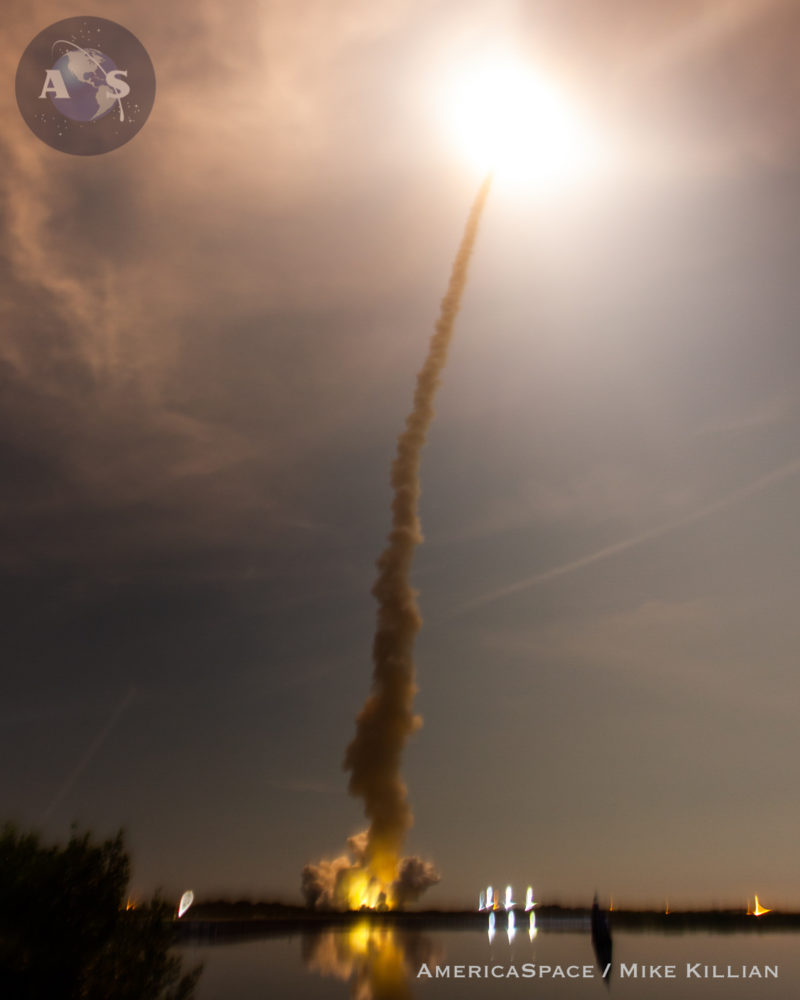
A minute later, protective panels surrounding Orion’s European Service Module (ESM) were jettisoned—exposing its stowed solar arrays—and at three minutes and 30 seconds the Launch Abort System (LAS) was discarded to expose the Crew Module (CM) to the space environment for the first time. By now, the stack was traveling at well over 4,500 miles per hour (7,200 kilometers per hour) at an altitude of 54.4 miles (87.6 kilometers).
The four RS-25 engines of the Core Stage continued to burn hot and hard after the departure of the boosters. They finally burned out at Main Engine Cutoff (MECO), precisely targeted for eight minutes and 20 seconds into the flight, at a velocity of 17,430 miles per hour (28,000 kilometers per hour) and an altitude of 100.6 miles (161.9 kilometers). By now, the stack had shed much of its liftoff mass and weighed just 400,000 pounds (180,000 kilograms) at MECO.
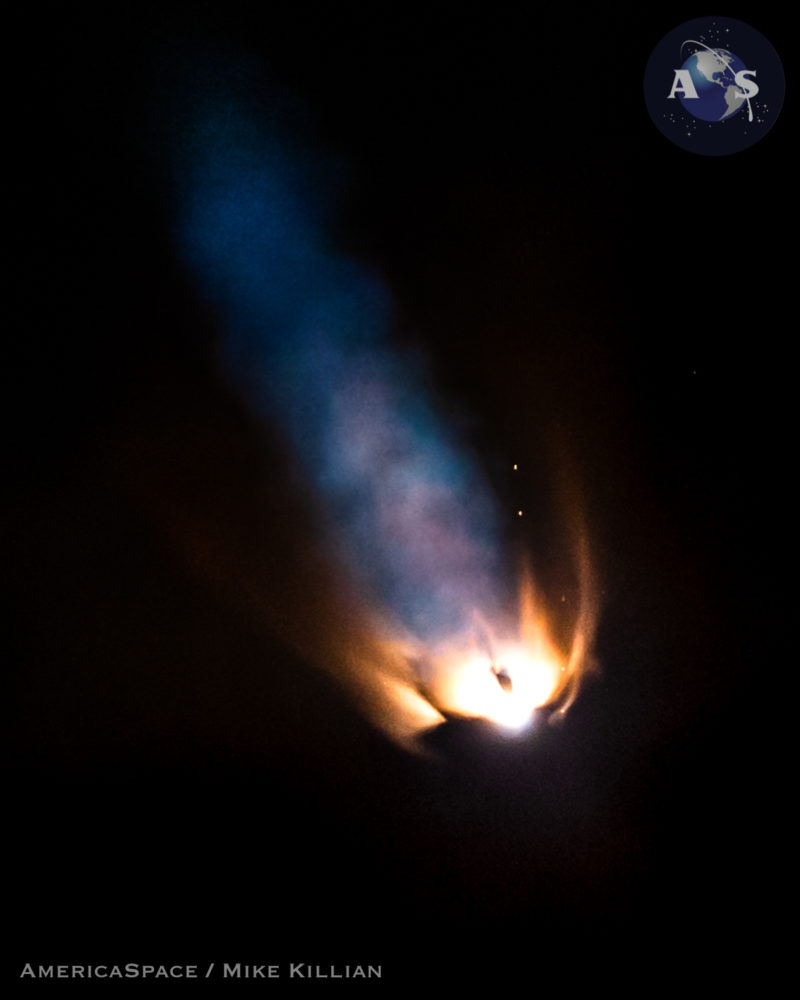
Ten seconds or so after MECO, the 21-story Core Stage separated, leaving the ICPS/Orion combo alone. As this story was being written, the spent Core Stage impacted the Pacific Ocean, somewhere between Hawaii and the West Coast of the United States, about 106 minutes after launch.
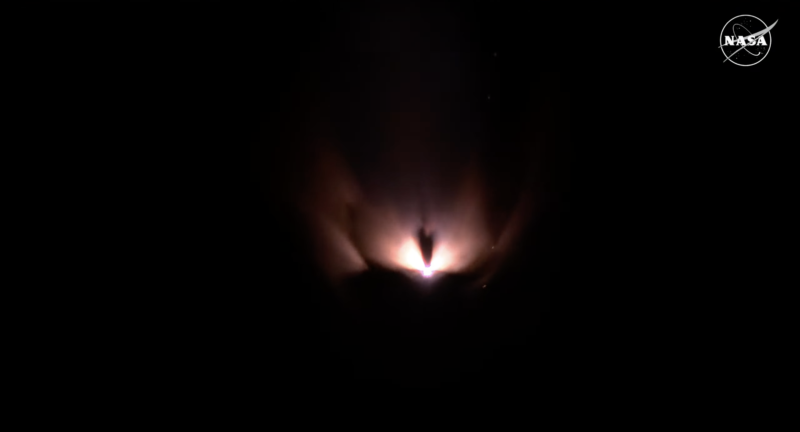
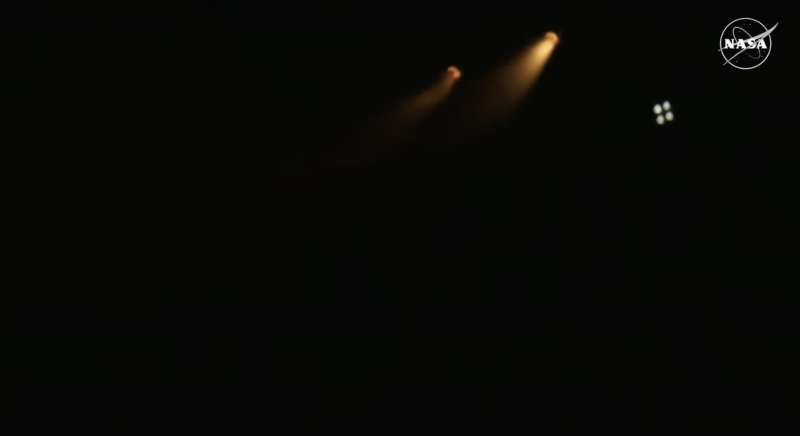
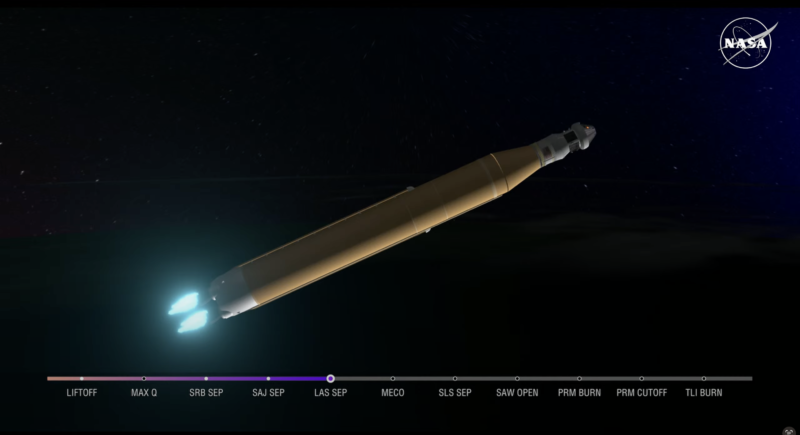
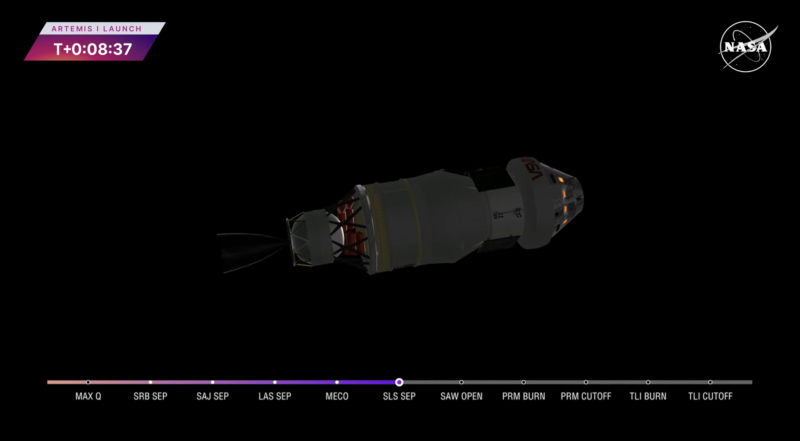
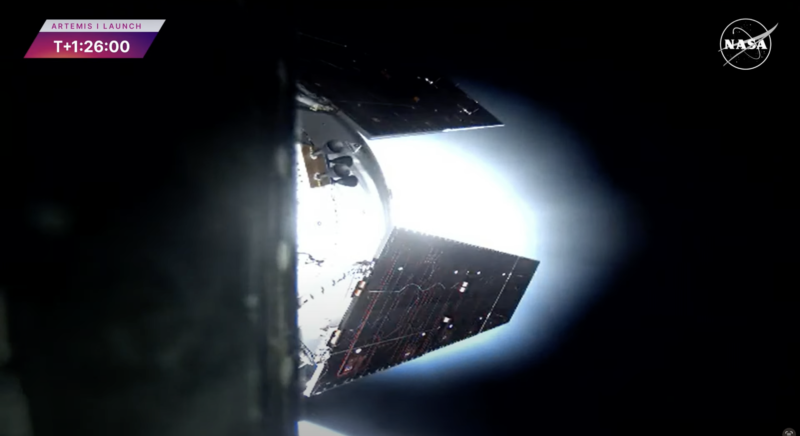
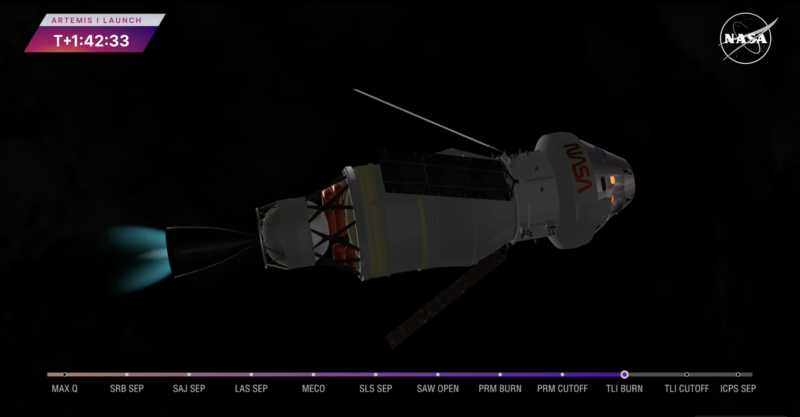
Orion’s solar arrays were due to begin to deploy some 18 minutes after launch and be secured in place within 12 minutes. It will then be the task of the 45-foot-tall (13.7-meter) ICPS and its powerful RL-10 engine to commit a pair of critical “burns” to firstly raise the “low-point” (or perigee) of Orion’s orbit from 18.4 miles (29.6 kilometers) to 115 miles (185.2 kilometers) and secondly to send the spacecraft out of Earth’s gravitational well and onto a course for the Moon.
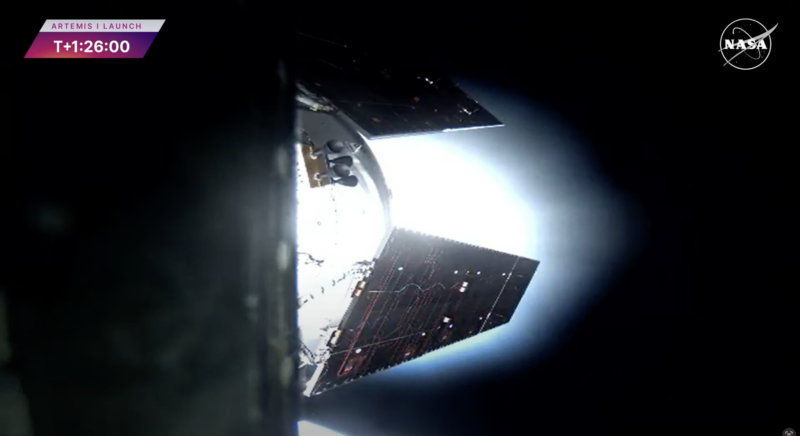
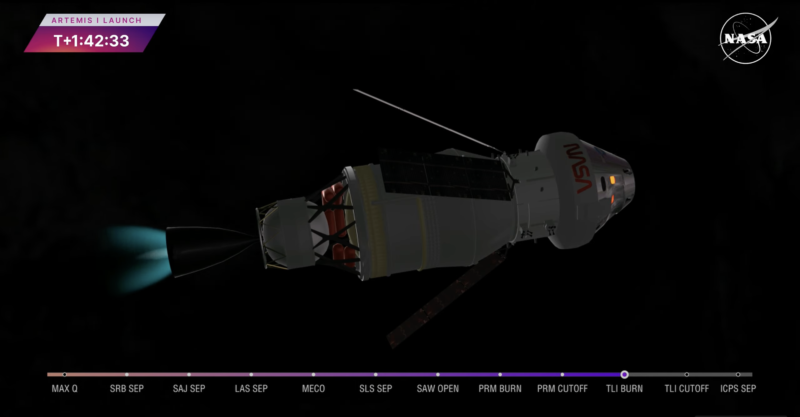
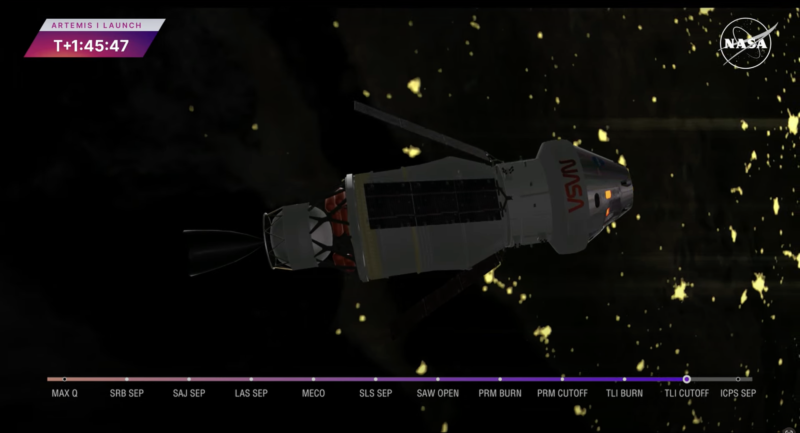
The Perigee Raise Maneuver (PRM) will occur about 51 minutes after launch. But it will be the Translunar Injection (TLI) burn—due to begin 97 minutes into the flight and see the RL-10 engine fire for 18 minutes—which will surely captured the public’s imagination, sending a crew-capable spacecraft out of low-Earth orbit and towards the Moon for the first time in almost five decades.
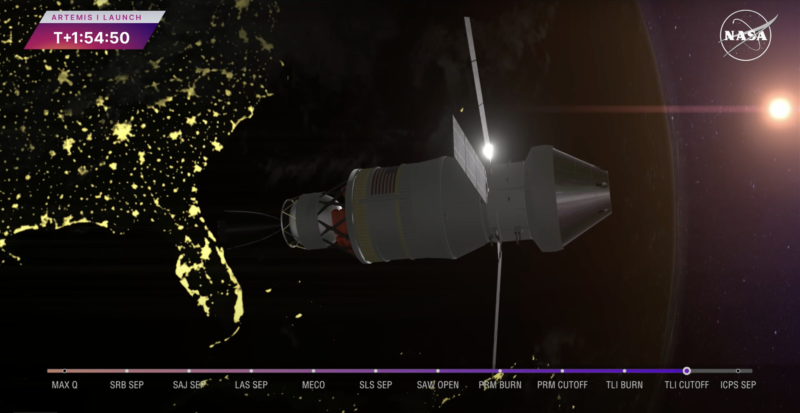
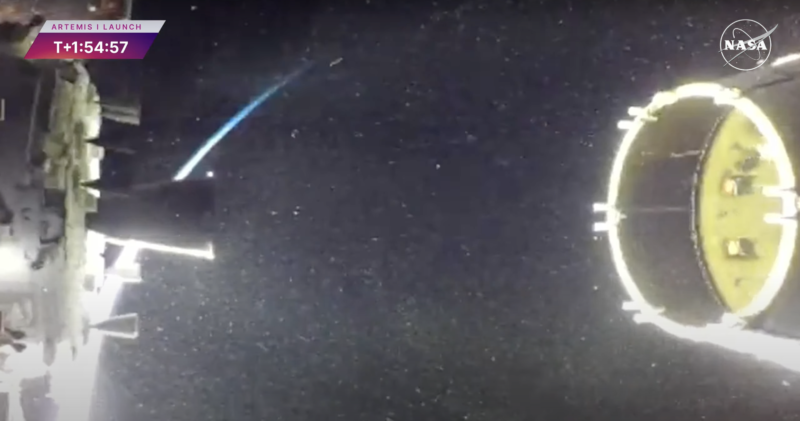
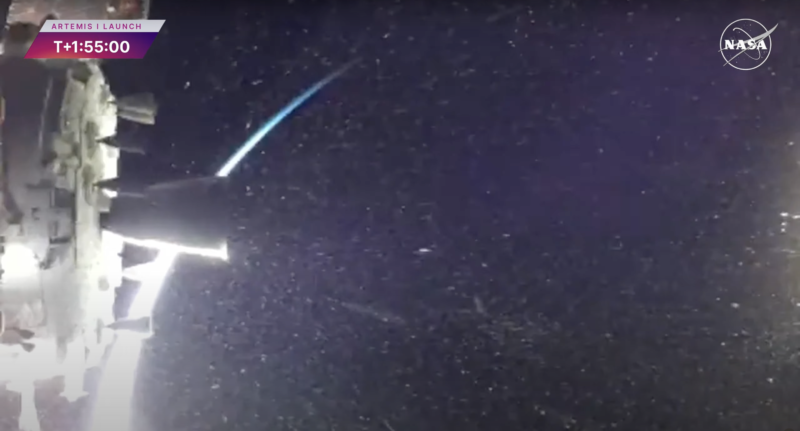
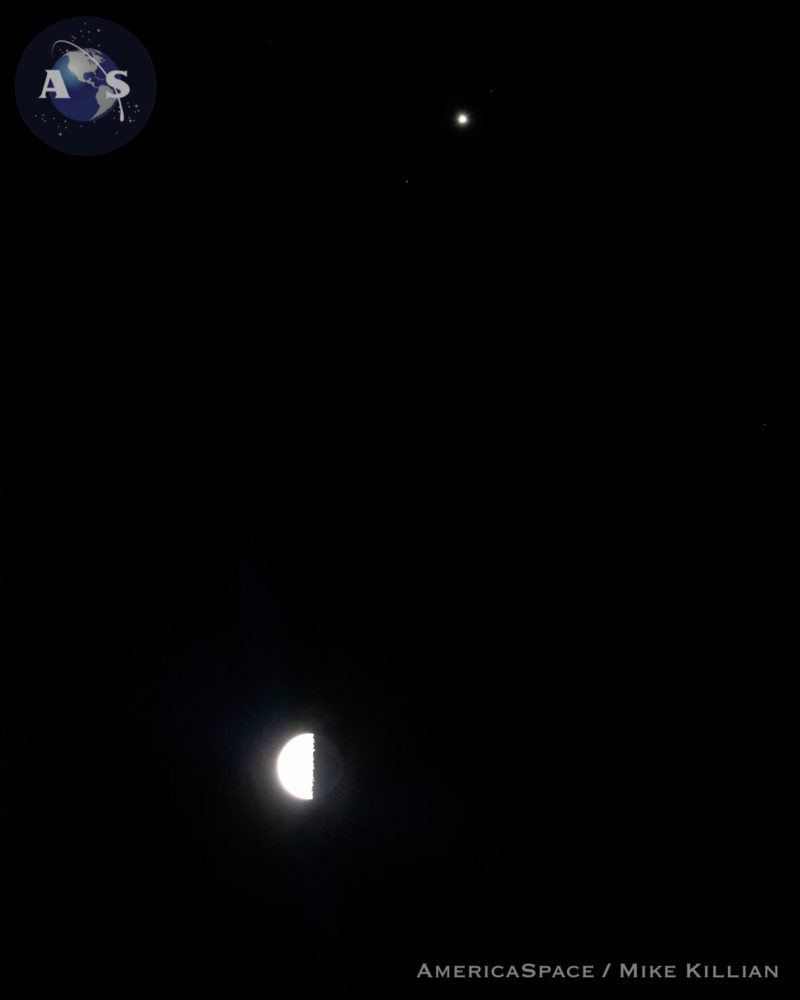
When Orion and the ICPS part company a little over two hours after launch, they will be traveling at 19,625 miles per hour (31,580 kilometers) at an altitude of 2,300 miles (3,700 kilometers). And this will commit Orion to her 25.5-day mission around the Moon.
Extensive systems and hardware testing will be conducted during the next three-and-a-half weeks to validate the performance of the spacecraft in the high-radiation environment of cislunar space to carry humans on Artemis II in the second half of 2024. Orion will return to Earth in early December, plunging into the atmosphere at 25,000 miles per hour (40,000 kilometers per hour) to splash down in the Pacific within a broad patch of ocean running from San Diego to Hawaii to Mexico’s west coast.
.
.
FOLLOW AmericaSpace on Facebook and Twitter!
.
.




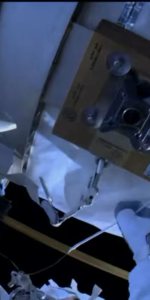
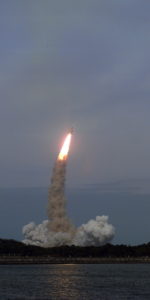
SLS survived tornadoes, hurricanes and New Space windbags as MSFC’s way of shoving it far up Musk’s taint-and….after that…who would want to re-use it anyway?
Alabama 1,
Texas 0…
Rammer Jammer
Elon!
A couple of questions: the story mentions that the SRBs parachute into the Atlantic. Why do the SRBs use parachutes when they’re non-recoverable?
Does the Core Stage use retro rockets of any sort that permit a controlled descent to occur into the Pacific after that stage has already reached orbital velocity?
The Core Stage does have retro rockets to assist in separation from the Orion-ICPS stack. The reason for those retro-rockets is to ensure that the Core Stage cleanly separates and doesn’t impact the ICPS, which doesn’t perform its perigee raising maneuver burn for several minutes after that separation.